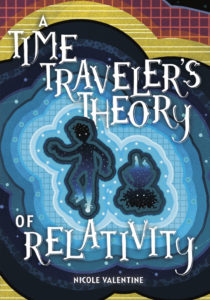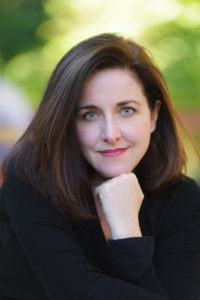He believes in science, but only magic can help his mom.
Twelve-year-old Finn is used to people in his family disappearing. His twin sister, Faith, drowned when they were three years old. A few months ago, his mom abandoned him and his dad with no explanation. Finn clings to the concrete facts in his physics books—and to his best friend, Gabi—to ward off his sadness. But then his grandmother tells him a secret: the women in their family are Travelers, able to move back and forth in time. Finn’s mom is trapped somewhere in the timeline, and she’s left Finn a portal to find her. But to succeed, he’ll have to put his trust in something bigger than logic.
Today, I’m thrilled to have my Vermont College of Fine Arts classmate and debut author Nicole Valentine on The Pirate Tree to discuss her middle grade novel A Time Traveler’s Theory of Relativity, due out next month from Carolrhoda Books. I was fortunate to have read an advance copy and was immediately captivated by her rich evocation of the Vermont town, the mystery of Finn’s disappearing family, and the secondary characters who offer support even though it may put them in danger.
LML: I remember you working on a version of this book at VCFA and know it went through many incarnations. What were some of these, and how did A Time Traveler’s of Relativity make its way into the world?
NV: Yes, I certainly took my time! It’s not easy writing time travel and it’s even harder when you’re working hard to imbue it with heart. I revised over and over again until it rang true. Then once I felt that I had the emotional arcs and the themes right – there was still the logical testing phase. I took the novel to some gamer friends and asked them to “break my system.” Time travel is its own kind of rule system. I wanted my world to feel entirely plausible, in order to do that I followed the rules of quantum physics until I pushed them past theoretical into magical territory.
What advice can you give to writers who are still “in the trenches” with their first novels?
Everyone’s situation is different, of course. If you can, listen to Ralph Waldo Emerson, “Adopt the pace of Nature, her secret is patience.” We can easily get caught up watching our peers move faster than ourselves and think we should be ready to query or submit. You know when your work needs more time. Don’t beat yourself up if it does. Enjoy and trust the process, and celebrate every rejection. They are rungs on the ladder. Just keep doing the work. Show up for yourself. Attend workshops, read the craft books. Do it all to honor that beautiful idea of yours. Then give that idea the time it deserves.
Loss and grief are major themes of the novel. What inspired you to address these themes, and how do you see it speaking to young readers?
I lost my father when I was twelve and that event divided my childhood in half, it was very much a bifurcation of my timeline. I think losing someone close to you feels like this no matter how old you are. While I think this book is a grand adventure for any reader, I believe that younger readers who have already grappled with grief will recognize how being lost in time and grieving someone are very similar. I’m hoping that they will feel less alone when they read about Finn and Gabi.
Your background is in technology and the intersection of technology and storytelling. How did your previous career contribute to the development of this story?
We are living in a time where critical thought and scientific study are under attack. It’s imperative to me that the next generation grow up trusting in facts and scientific data. I value my tech background and I know that it grew from a seed planted in my childhood. I turned to science because it generated the feeling of awe and wonder. It made me ponder things much bigger than myself, and in doing that, it gave me a form of refuge, a relief from the sad and often scary world I was living in. I hope the next generation will have a renewed faith in scientific study and I also want them to have hope. For me, the two came hand in hand. There is an inherent optimism in scientific thought. There is no finality. You keep going. You keep experimenting. You keep learning. Carl Sagan said it best, “Science is a way of thinking much more than it is a body of knowledge.”
My digital background taught me to think in a non-linear fashion. I’m used to writing modules and connecting them. I do most of my first drafts this way. I write scenes and I write their connective tissue around them. I move things around in Scrivener. There’s this feeling that I’m creating a world and the reader will enter it, but then they have the control. I’m creating a liminal space. They are filling in the rest. I leave them room to make assumptions and decisions. I think it’s so important to give the reader an active reading experience. And there are no readers I trust more with this task than children.
Let’s talk about setting and the way you capture perfectly the rhythms of life in a small town in Vermont. Did you grow up in a small town? How is a small town, as opposed to a suburb or large city, an ideal setting for this story?
I’m so glad you assumed I did! No, I grew up in both the Bronx and then a large suburb of New York City. I did, however, come from a large extended family that felt like its own village at times. I wanted a setting that seemed like it was both untouched by time and that could conceal a secret for generations. Dorset fit that bill perfectly. My family and I have been vacationing there for years. I have hiked Dorset Peak and yes, the tree with two doorknobs exists. I wish I could take credit for inventing the entire magical setting, but one visit would show you all I did was capture it on the page. It’s one of my favorite corners of the globe.
 I love the cover! Can you tell us more about how it came to be?
I love the cover! Can you tell us more about how it came to be?
The cover art is from the brilliant Alice Brereton. Lerner gave her the manuscript early on and she came up with several sketches. I was asked to narrow it down from four, the only problem was I loved them all! There was no way I could go wrong with this art team. Lerner does wonders with covers. I absolutely love what’s underneath and imprinted on the hardcover too.
Thank you!
Thank you! It’s a real pleasure being invited to talk with you.
#
Nicole Valentine (https://www.nicolevalentinebooks.com/) earned her MFA in Writing for Children and Young Adults from the Vermont College of Fine Arts and teaches writing workshops at the Highlights Foundation in Honesdale, PA. As the former chief technology officer at Figment.com and Space.com, Nicole loves science and as a writer enjoys pondering the times when science falls short of explanation and magic has room to sneak in. She’s the founder of steaMG.org, The Middle-Grade Sci-fi Authors Alliance. When not engaged in fictional world-building, Nicole can often be found with a hawk on her arm. A Time Traveler’s Theory of Relativity is her debut novel. She lives in Pennsylvania with her human family, two giant dogs named Merlin and Arthur, and two small cats named Tink and Pickwick.

1 comment for “An Interview with Nicole Valentine, Debut Author of A Time Traveler’s Theory of Relativity”